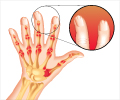Psoriatic arthritis is often undiagnosed or misdiagnosed. There is no definitive test for it and so patients suffer for years though it can be treated easily.

‘In the majority of cases psoriasis precedes psoriatic arthritis, with PsA often developing within five to ten years after the onset of psoriasis.’





Psoriatic arthritis (PsA) is an inflammatory condition closely related to and most often co-occurring with psoriasis. Both are chronic life-long autoimmune conditions. While psoriasis affects the skin, causing red, scaly patches that are often painful and itchy. PsA has highly variable symptoms that present in different patterns with different patients. Some of the most common symptoms are pain, swelling, and stiffness of the joints; inflammation and pain of ligaments and tendons at attachment points; and fatigue.
Almost two-thirds of survey respondents were also diagnosed with psoriasis, with 71% of these diagnosed with psoriasis first. Forty-four percent of respondents went more than 10 years between diagnoses.
Psoriatic arthritis is often undiagnosed or misdiagnosed. There is no definitive test for PsA, instead patients are evaluated most often with Classification Criteria for Psoriatic Arthritis (or CASPAR). On average, survey respondents went 6.6 years from symptom onset prior to diagnosis and underwent an average of 4.9 diagnostic tests.
Forty-one percent visited four or more healthcare professionals. This difficulty in diagnosis is made even more problematic because early diagnosis is critical. Treatment not only helps manage painful symptoms, but also can slow the potentially disfiguring progression of the disease.
Advertisement
Similar to other autoimmune diseases, there is currently no cure for PsA. In addition, over time symptoms progress and can cause permanent, irreversible joint damage. The most common symptoms are also the most difficult to manage. When asked to identify the most difficult symptoms to manage, 82% note fatigue; 80% painful, swollen, or stiff joints; and 61% lower back and/or neck pain.
Advertisement
Source-Eurekalert















